Aristobulus III of Israel (53 BC – 36 BC) was the last scion of the Hasmonean royal house, brother of Herod the Great's wife Mariamne, and paternal grandson of Aristobulus II. He was a favorite of the people on account of his noble descent and handsome presence, and thus became an object of fear to Herod, who at first sought to ignore him entirely by debarring him from the high priesthood. But his mother Alexandra Maccabeus (63 BC – 28 BC), through intercession with Cleopatra and Mark Antony, compelled Herod to remove Hananel from the office of High Priest and appoint Aristobulus instead.
To secure himself against danger from Aristobulus, Herod instituted a system of espionage against him and his mother. This surveillance proved so onerous that they sought to gain their freedom by taking refuge with Cleopatra. Their plans were betrayed, however, and the disclosure had the effect of greatly increasing Herod's suspicions against his brother-in-law. As he dared not resort to open violence, he caused him to be drowned while he was bathing in Jericho.
This article was taken from the Jewish Encyclopedia (1903).
*** it-1 p. 163 Aristobulus ***
(A·ris·tob´u·lus) [Best (Noblest) Counselor].
An individual, some of whose household in Rome were sent greetings by Paul.—Ro 16:10.
"According to Josephus, Alexandra asked Cleopatra, queen of Egypt, to intercede with Mark Antony on her son's behalf. Antony ignored her request, but he summoned Aristobulus on the advice of Delius, a Roman who had visited Jerusalem and admired both the lad's good looks and the beauty of Mariamne." Jewish Virtual Library
Alexandra II would not be thwarted and sent a secret letter to her friend, Queen Cleopatra VII in Egypt, King Herod’s arch rival and nemesis. Cleopatra, in turn, sent a letter to Mark Antony seeking his assistance in the appointment of Alexandra’s son to the office of the high priest. When Antony’s lover, Dellius, was in Jerusalem, he saw the young prince, Aristobulus, and immediately admired both he and his sister, Miriamme I, now the wife of King Herod. He told Alexandra, to send paintings of her two children to the legendary Roman which she did. Herod, in his true style, with every servant reporting to him about everyone else, found out, but kept his peace till a future day. King Herod was in a bind. Herod had become king of Judea because of the favor to him by Mark Antony. He knew that Cleopatra would every moment she could, seek to influence Antony to remove the royal Jewish throne from the man, Herod, whom she hated.(BibleSearchers.com)
I also saw a documentary about King Herod which described this scene in detail and corroborates the above. It was well known the Mark Antony was bisexual. Aristobulus’ mother, Alexandra was no doubt using the paintings sent to Mark Antony of Aristobulus to entice Mark Antony to appoint her son to the office of High Priest. This was a blatant overture appealing to Mark Antony’s love of young beautiful men. Mark Antony actually sent for Aristobulus, but Herod intervened fearing Ari would be made King and appointed Ari as High Priest, thus Ari never made the journey to meet Antony.
What if Ari had made the trip to be by Antony’s side?
Does one entice such a powerful leader appealing to his sexual appetites then refuse to appease those appetites? Of course not. That would be foolish. One may rightfully conclude that Ari was in fact gay or bi-sexual, in this case openly so. Even if he wasn’t, he was willing to submit sexually to another man. If homosexuality were really prohibited by the Levitical Law, this would certainly be in direct violation of that Law and would have resulted in Ari’s execution by the Jews.
I think this is evidence that the Jews in Herod’s and Ari’s time did not view homosexuality the same as today’s Christians interpret Levitical Law, and neither does it particularly harmonize with Christian Fundamentalists' view of homosexuality.
